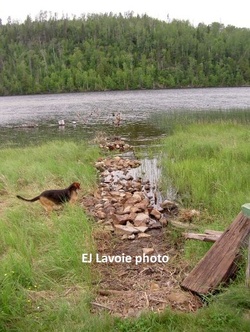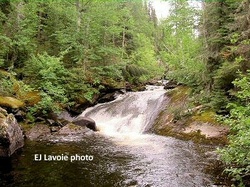
 If a tree falls in the forest and there is no one there to hear it, does it make a sound? The answer is yes. If a tsunami sweeps across an inland lake in the boreal forest, and there is no one there to see it, did it happen? Maybe. It depends on the track it leaves. I have paddled across a big lake in a storm, in the teeth of a gale, for a solid two hours, non-stop, because if I stopped, I was dead. When I finally looked back, there was no track. It might have never happened. Lake Nipigon is one of Canada's biggest lakes. I have canoed it, but . . . never in a storm. I was caught in a storm there once, and, apparently, I lived. If I'd been out paddling a couple weeks ago, I would have, apparently, died. In this neck of the woods, they call a tsunami a seiche (pronounced SAY –sh). A strong westerly wind piled the water into a ridge and sent it rippling across the broad expanse of Lake Nipigon into the southeast arm, where the steep hills and narrowing corridor exacerbated the phenomenon. I know it happened because I saw its track, two weeks later. In September of 2009, my friend Peter took me sailing up the arm and into the open lake. I was researching the shoreline for my novel, The Beardmore Relics. It was breezy, but pleasant. And we returned safely, apparently, to the dock. That dock is no longer there . . . ORIGINAL POST June 2011 Read the full post with colour photos on E.J. Lavoie's Blog > http://bit.ly/2cCrgB0  I am constantly amazed by my friends and neighbours because so many are so unfamiliar with their backyards. I could place a bet that 90% of them could not locate the Kamuck River on a map without serious help. Probably 80% have never visited Poplar Lodge Park. Probably 70% could not name the Pallisades of the Pijitawabik, although they pass them every time they go to Thunder Bay. I’m not faulting them. I’m just stating a fact about people in general – we are almost oblivious to our surroundings. We have to teach ourselves to be aware, and I include me in that “we”. So last night on The National, when Peter Mansbridge flirted on air with Claire Martin, as per usual, maybe she was a little flustered. Claire is Senior Meteorologist for the CBC. I really enjoy her two-minutes of fame every weekday evening. She was pointing out that Northern Ontario would be assaulted, for the third night in a row, by an overnight frost. And the coolest community (in a temperature sense only) would be Armstrong. Armstrong. Guaranteed that 95% of my friends and neighbours have heard of the place – they know it is somewhere west of us. On the west side of Lake Nipigon. Ninety-nine point nine per cent of them have never been there, and have no immediate plans to visit. Claire pointed out its location for the benefit of 99.99% of TROC (the rest of Canada). She located it between Timmins and North Bay, a long, long way east of us, close to the Quebec border. Claire, I forgive you, and millions of your fans will too. And Peter, shame on you. Let the poor woman do her job. ORIGINALLY POSTED 27 MAY 2011 Read other posts with colour images on E.J. Lavoie's Blog > http://bit.ly/1oXc9jS  ORIGINAL POST ON 26 MAY 2011 Decades ago, I read The Strange One by Fred Bodsworth. The story is set in Northeastern Ontario, between Timmins and Moosonee, and one of the characters is a barnacle goose. This goose resembles a Canada goose, but it is native to Europe. In the story the barnacle goose is driven off its migratory route by storms and ends up at the bottom of James Bay. There it links up with a flock of Canada geese. In the flock, it is “the strange one”. In the story a Native girl from James Bay leaves her community to educate herself in “Canada”. When I taught in Moose Factory 50 years ago, the community joke was that anyone taking the train to Cochrane was “going to Canada”. In “Canada”, the girl finds herself regarded as “the strange one”. Okay, this is not about the goose or the girl. This is a meditation on place – on its vital function in a story. I was so enamoured of Bodsworth’s description of the natural home of the barnacle goose, in the Outer Hebrides of Scotland, that when I had an opportunity, I checked it out. Yes, I went searching for the stretch of seashore described on the island of Barra in the Outer Hebrides . . . Read the full post with colour photo on E.J. Lavoie's Blog > http://bit.ly/2bxZWlp |
Author
E.J. Lavoie contributes a weekly column to Greenstone's Coffee Talk and the Nipigon-Red Rock Gazette. The column can be read in its entirety on his blog, complete with images. Just click the link at the end of each post. Archives
November 2016
Categories |
 RSS Feed
RSS Feed
